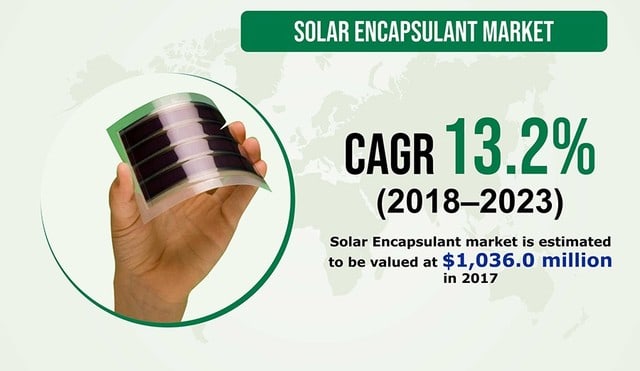Rising burden on conventional energy sources for power generation has become a major environmental concern as fossil fuels are depleting at a worrisome rate, and their combustion results in the release of toxic pollutants in the environment. This is contributing massively to global warming. Therefore, alternate sources of energy, such as wind, water, and solar, are being pursued for clean energy generation. The most popular renewable energy is solar, which makes use of photo voltaic (PV) technology. This technology is capable of directly converting sunlight into electrical energy. PV modules are being heavily deployed for harnessing solar power, as they offer numerous benefits, such as environmental sustainability, economic viability, and clean energy. Many countries are now increasingly investing in the manufacture of PV modules, for instance, China has increased its installed capacity of solar power generation to 48 GW, which is further expected to reach 110 GW by 2020, as mentioned by the China Photo Voltaic Industry Association. Solar encapsulants are products that are used for providing adhesion between the top and rear surfaces of the module to offer protection from high moisture, temperature, and external stress.
Solar encapsulants are based on the following materials: polyolefin elastomer, ethylene vinyl acetate (EVA), polyvinyl butyral (PVB), polydimethylsiloxane, ionomers, and thermoplastic polyurethane. Of all, the demand for EVA-based solar encapsulant was the highest during the 2013–2017 period. EVA is a copolymer of ethylene and vinyl acetate and it is highly elastic which can be molded into any form. Owing to its excellent toughness, it is extensively used in the PV industry. Further, EVA is preferred because it is cost-effective and highly efficient. It even protects modules from dirt, humidity, external shocks, delamination, corrosion, and vibration. In the coming time, the fastest growth in demand is expected to be witnessed by the PVB material-based encapsulants. PVB is an amorphous copolymer of vinyl alcohol, vinyl butyral, and vinyl acetate. It provides module durability and increases lamination yield. A study conducted by P&S Intelligence has predicted the solar encapsulant market to register a 28.4% CAGR in the coming years.
Get free sample copy of market overview at:
https://www.psmarketresearch.com/market-analysis/solar-encapsulation-market/report-sample

Solar encapsulants find their application in various sectors, such as automotive, electronics, construction, defense, and aerospace. The construction sector was the largest end user of these encapsulants throughout the 2013–2017 period. To harness electricity generated from sunlight, solar panels are installed on roofs of residential and commercial buildings, which is then used to operate electronic devices, such as solar heaters, fans, and lights. Further, owing to their high thermal resistivity and durability, they are being preferred to be used in green building construction. Therefore, due to their heavy deployment in buildings, this sector would continue to generate the highest demand for solar encapsulants, keeping the abovementioned factors in mind.
The increasing interest of manufacturers and consumers in solar panels is inviting more investments, thereby resulting in rising research and development activities for improving the durability and efficiency of solar cells, and solar encapsulants. Continuous efforts of scientists and researchers have led to the development of third-generation PVs that are superior than their predecessors. Technological advancements have made the manufacturing of solar encapsulants comparatively easy, which has helped reduce their prices, thereby adding to the demand for solar encapsulants. This can be a massive opportunity for growth for the manufacturers dealing in this market.
Solar encapsulants are based on the following materials: polyolefin elastomer, ethylene vinyl acetate (EVA), polyvinyl butyral (PVB), polydimethylsiloxane, ionomers, and thermoplastic polyurethane. Of all, the demand for EVA-based solar encapsulant was the highest during the 2013–2017 period. EVA is a copolymer of ethylene and vinyl acetate and it is highly elastic which can be molded into any form. Owing to its excellent toughness, it is extensively used in the PV industry. Further, EVA is preferred because it is cost-effective and highly efficient. It even protects modules from dirt, humidity, external shocks, delamination, corrosion, and vibration. In the coming time, the fastest growth in demand is expected to be witnessed by the PVB material-based encapsulants. PVB is an amorphous copolymer of vinyl alcohol, vinyl butyral, and vinyl acetate. It provides module durability and increases lamination yield. A study conducted by P&S Intelligence has predicted the solar encapsulant market to register a 28.4% CAGR in the coming years.
Get free sample copy of market overview at:
https://www.psmarketresearch.com/market-analysis/solar-encapsulation-market/report-sample

Solar encapsulants find their application in various sectors, such as automotive, electronics, construction, defense, and aerospace. The construction sector was the largest end user of these encapsulants throughout the 2013–2017 period. To harness electricity generated from sunlight, solar panels are installed on roofs of residential and commercial buildings, which is then used to operate electronic devices, such as solar heaters, fans, and lights. Further, owing to their high thermal resistivity and durability, they are being preferred to be used in green building construction. Therefore, due to their heavy deployment in buildings, this sector would continue to generate the highest demand for solar encapsulants, keeping the abovementioned factors in mind.
The increasing interest of manufacturers and consumers in solar panels is inviting more investments, thereby resulting in rising research and development activities for improving the durability and efficiency of solar cells, and solar encapsulants. Continuous efforts of scientists and researchers have led to the development of third-generation PVs that are superior than their predecessors. Technological advancements have made the manufacturing of solar encapsulants comparatively easy, which has helped reduce their prices, thereby adding to the demand for solar encapsulants. This can be a massive opportunity for growth for the manufacturers dealing in this market.










